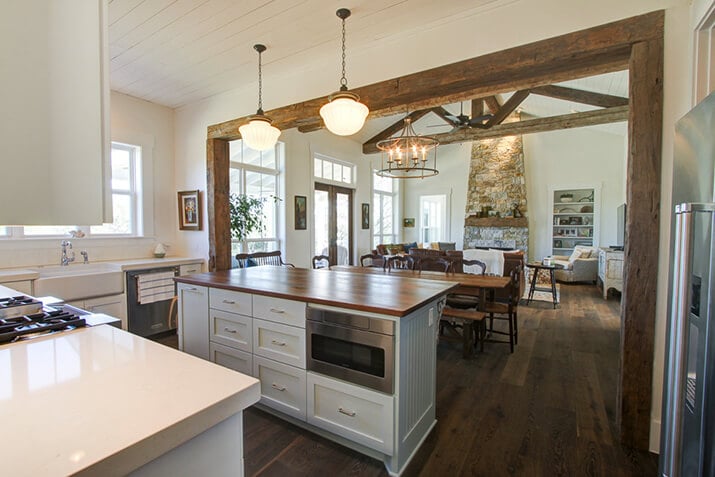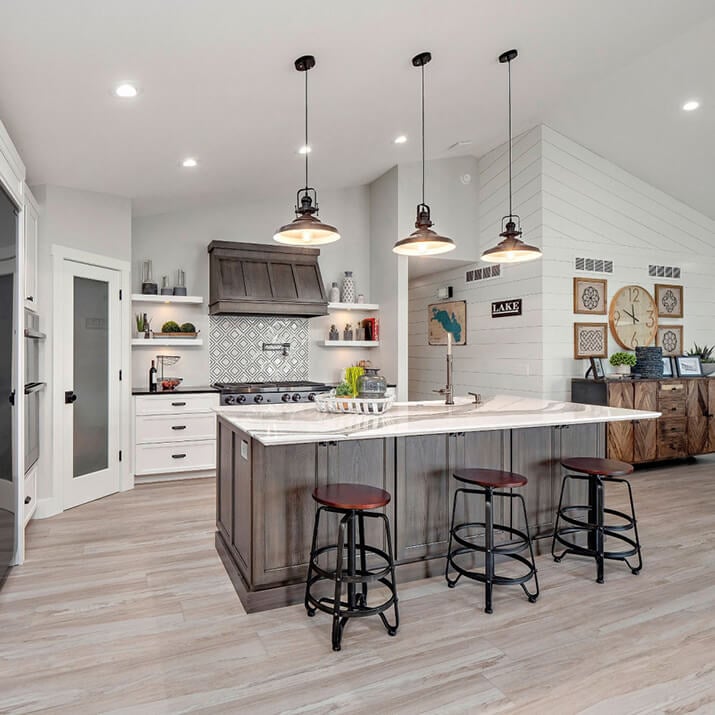Kitchen
Tips for Blending an Open Kitchen with the Rest of the Home
Designing and decorating your home is already tricky enough when each room serves a specific purpose. But when all those rooms become one, it can be hard to have a cohesive vibe flow throughout the space, tying together each element from your kitchen to your living room. Here’s how to blend an open-concept kitchen with the rest of your home.
Create a Visual Display

Although a trendy design option, open kitchen shelving is an effective way to marry the two rooms. With open shelving on the kitchen walls, you can curate a display of kitchen items such as stoneware dinner plates or ceramic mugs that have the same aesthetic as the decorations in your living room. Think of the shelving in your kitchen as you would any shelving in your living room. Combine a mixture of knickknacks and kitchen items to create a comfortable cooking space that feels harmonious with the entire living space.
Feature a Neutral Palette

Bold colors and textures in a kitchen can be fun and add a lot of character ? but it can also make the kitchen feel less like an extension of a space and more like its own design concept. When designing your kitchen, consider the color scheme you have running throughout the entire room. Do the wood cabinets in your kitchen match the tones in your living room furniture? Does the color of your kitchen represent a specific design element of your dining room? Finding ways to subtly carry over similar neutral tones and hues between the multiple spaces will help unify the rooms.
Build Definitive Areas

It may seem counterintuitive when trying to blend an open-concept space together, but you should still create definitive areas that clearly outline where the kitchen, dining room, and living room end and the new room begins. Defining the space allows the rooms to look cohesive while still clearly serving a particular purpose. One of the easiest ways to define various areas in the space is to use area rugs to counteract the lack of natural division. There are many ways to integrate them into the floor plan, from having an area rug in the middle of your living room furniture and underneath your dining room table to runners along the kitchen floors.
Add Architectural Details

When designing your kitchen, it’s easy to forget about the wall. But the architectural details on the walls are something you should not overlook! Using lines in your kitchen design can help draw your eye around the room, seeing it as a seamlessly unified space. Consider installing molding, trim, or paneling along the walls between the two rooms, which will help the transition from room to room. You can also use these architectural details to differentiate the adjoining rooms to add some character and charm.
Maintain a Clean and Tidy Space

If you’re trying to create a cohesive vibe from room to room, the last thing you want is for something to break up a seamless appearance. Whether you have clutter, such as appliances like a toaster, blender, and food processor or pots and pans, atop your kitchen counters or items piling up on your kitchen barstool, you should find ways to hide any excess items from view to ensure your eyes can easily travel around the open-concept floor plan without falter.
Frequently Asked Questions
What is an open-concept kitchen?
An open-concept kitchen refers to a kitchen that doesn’t have walls separating it from the rest of the home. Instead, the kitchen’s floor plan extends into the other rooms, including the dining room, living room, family room, or other rooms on the main floor. As a result, you’re left with a large room with defined areas for each purpose.
How to light an open plan kitchen?
Because an open-concept floor plan is a wide-open space, you need to find a way to effectively light the kitchen so that it creates a transition from the kitchen to the dining room and so on. Natural light from ample windows is the most effective way to create a harmonized transition, but installing adequate lighting over top of your kitchen island and recessed lighting in the ceiling is just as effective.
Are there cons of an open-concept kitchen?
Although there are many benefits to designing an open-plan kitchen that blends seamlessly with the other rooms of your home, the open-concept design may not be for everyone. If you tend to have messes or clutter build up in your kitchen, it may be best to have a closed kitchen from the rest of the living area. An open-plan kitchen can make many dinner parties or family gatherings feel less intimate and add more distance between your guests. You also need to factor in that it may cost you more money to effectively heat or cool one large room versus multiple smaller rooms.
How do you hide clutter in an open kitchen?
If you’re set on designing an open plan kitchen but know you have many kitchen appliances or clutter that can make the room appear less tidy, it’s a good idea to incorporate ways to hide clutter. Depending on your kitchen design, you can add a hutch where you can easily store kitchen appliances while they’re not in use. Otherwise, you can find creative ways to store the items you typically store on your counter on open kitchen shelving.
![See your dream kitchen in 3D [GET YOUR FREE DESIGN]](https://cdn.kitchencabinetkings.com/blog/wp-content/uploads/see-your-dream-kitchen-in-3d.webp)
![Contractor Discount Program: Offering contractors and builders special volume discounts on all applicable orders [LEARN MORE]](https://cdn.kitchencabinetkings.com/blog/wp-content/uploads/contractor-discount-program.webp)
![Explore our photo gallery [GET INSPIRED]](https://cdn.kitchencabinetkings.com/blog/wp-content/uploads/explore-our-photo-gallery.webp)
![What everyone is saying about KCK [READ REVIEWS]](https://cdn.kitchencabinetkings.com/blog/wp-content/uploads/what-everyone-is-saying-about-kck.webp)
![Get a cabinet sample [SHOP SAMPLES]](https://cdn.kitchencabinetkings.com/blog/wp-content/uploads/get-a-cabinet-sample.webp)
![Pay over time, on your terms with Affirm [LEARN MORE]](https://cdn.kitchencabinetkings.com/blog/wp-content/uploads/pay-over-time-on-your-terms-with-affirm.webp)